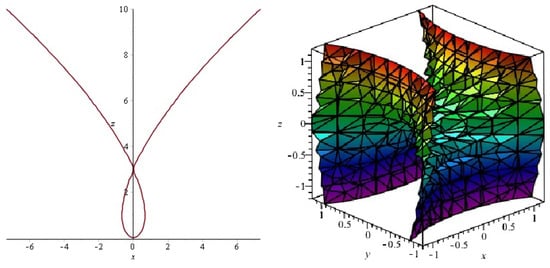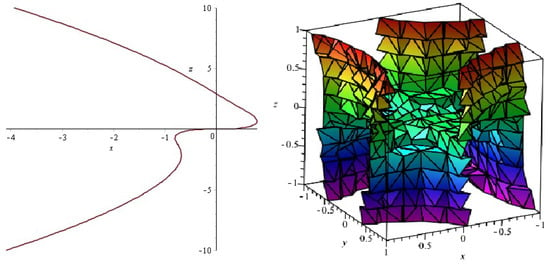Abstract
We consider a family of higher degree Enneper minimal surface for positive integers m in the three-dimensional Euclidean space . We compute algebraic equation, degree and integral free representation of Enneper minimal surface for . Finally, we give some results and relations for the family .
1. Introduction
Minimal surfaces have an important role in the mathematics, physics, biology, architecture, etc. These kinds of surfaces have been studied over the centuries by many mathematicians and also geometers. A minimal surface in is a regular surface for which the mean curvature vanishes identically.
There are many important classical works on minimal surfaces in the literature such as [1,2,3,4,5,6,7,8,9,10]. However, we only see a few notable works about algebraic minimal surfaces, including general results and the properties. They were given by Enneper [11,12], Henneberg [13,14] and Weierstrass [9,15].
One of them is the classical Enneper minimal surface that was given by Enneper. See [11,12] for details. About Enneper minimal surface, many nice papers were done such as [16,17,18,19,20,21,22,23,24] in the last few decades.
In this paper, we introduce a family of higher degree Enneper minimal surface for positive integers m in the three-dimensional Euclidean space . In Section 2, we give the family of Enneper minimal surfaces We obtain the algebraic equation and degree of surface (resp., ). Using the integral free form of Weierstrass, we find some algebraic functions for in Section 3. Finally, we give some general findings for a family of higher degree Enneper minimal surface with a table in the last section.
2. The Family of Enneper Minimal Surfaces
We will often identify and without further comment. Let be a three-dimensional Euclidean space with natural metric
Let be an open subset of . A minimal (or isotropic) curve is an analytic function such that where , and In addition, if then is a regular minimal curve.
Thus, let see the following lemma for complex minimal curves.
Lemma 1.
Let be a minimal curve and write Then,
lead to the Weierstrass representation of That is,
Therefore, we have minimal surfaces in the associated family of a minimal curve, as given by the following Weierstrass representation theorem [9] for minimal surfaces:
Theorem 1.
Let and be two holomorphic functions defined on a simply connected open subset of such that F does not vanish on . Then, the map
is a minimal, conformal immersion of into and is called the Weierstrass patch.
We now consider the Enneper’s curve of value m:
Lemma 2.
The Enneper’s curve of value m
is a minimal curve in , where , .
Then, we have . Hence, Enneper’s surface of value m in is
Lemma 3.
The Weierstrass patch determined by the functions
is a representation of Enneper’s higher degree surfaces , where
For , we get the classical Enneper’s surface (see also [4,11,25] for details).
Remark 1.
Note that the catenoid and classical Enneper’s surface are the only complete regular minimal surfaces in with finite total curvature .
See [5] for details.
Gray, Abbena and Salamon [26] gave the complex forms of the Enneper’s curve and surface of value m. Therefore, the associated family of minimal surfaces is described by
When (resp. we have the Enneper’s surface of value m (resp. the conjugate surface ).
The parametric equation of , in polar coordinates, is
Using the binomial formula, we obtain the following parametric equations of
Next, we will focus on the algebraic equation and degree of surface
With the set of roots of a polynomial gives an algebraic surface. An algebraic surface is said to be of n, when
It is seen that for (see also Table 1 for details). Using polynomial eliminate methods, we calculate the algebraic equations and degrees of the surfaces . For the surface (i.e., classical Enneper surface), it is known that the surface has degree 9. Thus, it is also an algebraic minimal surface. For expanded results of , see [4].
2.1. Algebraic Equation of Enneper Minimal Surface
The simplest Weierstrass representation gives classical Enneper minimal surfaceof value 1. In polar coordinates, the parametric equation of is
where , . The parametric form of the surface in coordinates, is
where .
Lemma 4.
A plane intersects an algebraic minimal surface in an algebraic curve [13].
See also [4] for details. Considering the above lemma, we find the algebraic equation of the curve
on the -plane is as follows (see Figure 1, left):
and its degree is Thus, -plane intersects the algebraic minimal surface in an algebraic curve .

Figure 1.
left: algebraic curve ; right: algebraic surface .
Using the polynomial eliminate method, we calculate the irreducible algebraic equation of surface by hand as follows (see Figure 1, right):
Its degree is . Therefore, is an algebraic minimal surface. All of these results for classical Enneper surface were obtained first in [11] by Enneper.
Next, we study algebraic equations and degrees of the higher degree Enneper minimal surfaces for values m = 2 and m = 3.
2.2. Algebraic Equation of Enneper Minimal Surface
In polar coordinates, the parametric equation of is
where , . The parametric form of the surface in coordinates, is
where .
Using the polynomial eliminate method, we find the algebraic equation of the curve
on the -plane as follows (see Figure 2, left)
and its degree is Hence, -plane intersects the algebraic minimal surface in an algebraic curve .

Figure 2.
left: algebraic curve ; right: algebraic surface .
We calculate the irreducible algebraic equation of surface by using Maple software (version 17, Waterloo Maple Inc., Waterloo, ON, Canada) as follows (see Figure 2, right)
and its degree is . Hence, is an algebraic minimal surface.
2.3. Algebraic Equation of Enneper Minimal Surface
The parametric equation of Enneper’s minimal surface of value 3, in polar coordinates, is
where , . In coordinates, has the following form:
where .
We get the algebraic equation of the curve
on the -plane as follows:
Its degree is Then, we see that the -plane intersects the algebraic minimal surface in an algebraic curve .
In Cartesian coordinates the algebraic equation of surface by using Maple software is as follows:
Its degree is . Thus, is an algebraic minimal surface.
Corollary 1.
The family of higher degree (also classical) Enneper minimal surfaces are algebraic minimal surfaces, where (see Table 1).
Next, we obtain the general algebraic equation for the curve :
Corollary 2.
We consider the curve
on the -plane. By using Mathematica (version 8, Wolfram Research Inc., Champaign, IL, USA; Oxfordshire, UK; Tokyo, Japan; Boston, MA, USA), we get the following algebraic equation:
where and its degree is
3. Integral Free Form
Integral free form of the Weierstrass representation (see [15]) is
where algebraic function and the functions are connected by the relation
for Integral free form is suitable for algebraic minimal surfaces. For instance, gives rise to classical Enneper minimal surface (see [4] for details).
After some calculations by using the last two equations above, we get following corollary:
Corollary 3.
We obtain algebraic functions , and then get the function which leads to Enneper minimal surface . We also find for for and so on.
Hence, we have following lemma:
Lemma 5.
The algebraic function in the integral free form for a higher degree (also classical) Enneper minimal surfaces is as follows:
where
4. Conclusions
Briefly, we give all findings, calculated in Section 2 and Section 3 for the Enneper surface family, in Table 1 as follows.

Table 1.
Algebraic Enneper minimal surfaces .
Looking at the table above, we also have the following results:
Corollary 4.
We find the following relation between degree of algebraic function in the integral free form and curve of surface :
and
where integers .
Remark 2.
For integers , algebraic equations and also degrees of Enneper minimal surfaces can be calculated. However, calculation is a time problem for software programmes.
Funding
This research received no external funding.
Conflicts of Interest
The author declares no conflict of interest regarding the publication of this paper.
References
- Bour, E. Théorie de la déformation des surfaces. J. l’Êcole Imperiale Polytech. 1862, 22, 1–148. [Google Scholar]
- Demoulin, A. Sur les surfaces minima applicables sur des surfaces de revolution ou sur des surfaces spirales. Darboux Bull. 1897, 2, 244–252. [Google Scholar]
- Haag, J. Note sur les surfaces minima applicables sur une surface de revolution. Darboux Bull. 1906, 30, 75–94. [Google Scholar]
- Nitsche, J.C.C. Lectures on Minimal Surfaces. Volume 1. Introduction, Fundamentals, Geometry and Basic Boundary Value Problems; Translated from the German by Feinberg, J.M.; With a German Foreword; Cambridge University Press: Cambridge, UK, 1989. [Google Scholar]
- Osserman, R. A Survey of Minimal Surfaces; Van Nostrand Reinhold Co.: New York, NY, USA; London, UK; Melbourne, Australia, 1969. [Google Scholar]
- Rado, T. On the Problem of Plateau, 1st ed.; Springer: New York, NY, USA, 1933; Subharmonic Functions Reprint; Springer: New York, NY, USA; Heidelberg, Germany, 1971. [Google Scholar]
- Ribaucour, A. Etude des elassoides ou surfaces a courbure moyenne nulle. Mem. Cour. et Mem. Sav. Etr. Acad. Roy. Sci. Belg. Bruxelles. 1882, 44, 236. [Google Scholar]
- Schwarz, H.A. Miscellen aus dem Gebiete der Minimalflachen. J. für die reine und Angew. Math. (Crelle’s J.) 1875, 80, 280–300. [Google Scholar]
- Weierstrass, K. Untersuchungen über die flächen, deren mittlere Krümmung überall gleich null ist. Preuss Akad. Wiss. 1866, III, 219–220. [Google Scholar]
- Whittemore, J.K. Minimal surfaces applicable to surfaces of revolution. Ann. Math. 1917, 19, 1–20. [Google Scholar] [CrossRef]
- Enneper, A. Untersuchungen über einige Punkte aus der allgemeinen Theorie der Flächen. Math. Ann. 1870, 2, 58–623. [Google Scholar] [CrossRef]
- Enneper, A. Analytisch geometrische Untersuchungen. Gott. Nachr. 1868, 258–277, 421–443. [Google Scholar]
- Henneberg, L. Uber die evoluten der ebenen algebraischen kurven. Vierteljahresschr. Naturforsch. Ges. Zur. 1876, 21, 71–72. [Google Scholar]
- Henneberg, L. Determination of the lowest genus of the algebraic minimum surfaces. Br. Ann. 1878, IX/2, 54–57. [Google Scholar]
- Weierstrass, K. Mathematische Werke; Mayer & Muller: Berlin, Germany, 1903; Volume 3. [Google Scholar]
- Barbosa, J.L.M.; Colares, A.G. Minimal Surfaces in ℝ3; Lecture Notes in Mathematics 1195; Springer: Berlin, Germany, 1986. [Google Scholar]
- Barbosa, J.L.M.; Do Carmo, M.P. On regular algebraic surfaces of with constant mean curvature. J. Differ. Geom. 2016, 102, 173–178. [Google Scholar] [CrossRef]
- Cheshkova, M.A. On the geometry of Enneper’s surface. (Russian) Differentsialnaya Geom. Mnogoobraz 2007, 38, 139–142. [Google Scholar]
- Dumitru, D. Minimal surfaces that generalize the Enneper’s surface. Novi Sad J. Math. 2010, 40, 17–22. [Google Scholar]
- Fernandez, I.; Lopez, F.J. On the uniqueness of the helicoid and Enneper’s surface in the Lorentz-Minkowski space . Trans. Am. Math. Soc. 2011, 363, 4603–4650. [Google Scholar] [CrossRef]
- Kaya, S.; López, R. The Björling problem and Weierstrass-Enneper representation of maximal surfaces in Lorentz-Minkowski space. In Differential Geometry in Lorentz-Minkowski Space; University Granada: Granada, Spain, 2017; pp. 43–59. [Google Scholar]
- Kokubu, M. On a construction of higher codimensional minimal surfaces based on Enneper’s surface and the catenoid. (Japanese) Minimal surfaces and related topics (Kyoto, 1999). Sūrikaisekikenkyūsho Kōkyūroku 1999, 1113, 65–84. [Google Scholar]
- Odehnal, B. On algebraic minimal surfaces. KoG 2016, 20, 61–78. [Google Scholar]
- Velickovic, V. Visualization of Enneper’s surface by line graphics. Filomat 2017, 31, 387–405. [Google Scholar] [CrossRef]
- Dierkes, U.; Hildebrandt, S.; Sauvigny, F. Minimal Surfaces, 2nd ed.; Springer: Berlin/Heidelberg, Germany, 2010. [Google Scholar]
- Gray, A.; Abbena, E.; Salamon, S. Modern Differential Geometry of Curves and Surfaces with Mathematica®, 3rd ed.; Studies in Advanced Mathematics; Chapman & Hall/CRC: Boca Raton, FL, USA, 2006. [Google Scholar]
© 2018 by the author. Licensee MDPI, Basel, Switzerland. This article is an open access article distributed under the terms and conditions of the Creative Commons Attribution (CC BY) license (http://creativecommons.org/licenses/by/4.0/).